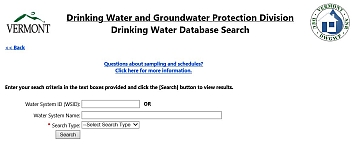Disinfection Byproducts and Their Regulation
Disinfection is used in public water systems to control microorganisms. This includes adding a chemical disinfectant such as hypochlorite or chloramine at the treatment plant. In Vermont, this is most often sodium hypochlorite, which is also used in household bleach. Chlorine products may also be added as part of other water treatment processes as a chemical oxidant. Disinfection byproducts (DBP) can form when naturally occurring organic carbon reacts with a chemical disinfectant such as chlorine. US EPA has more information on specific DBP compounds. Vermont Department of Health has more information on health effects of DBP.
A Community (C) or Non-Transient Non-Community (NTNC) public drinking water system that routinely and regularly applies a chemical disinfectant is regulated under the federal Stage 2 DBP Rule. Consecutive water systems that receive chlorinated water are also regulated under this rule. Organic carbon tends to be higher in surface water sources than in groundwater, so some of the DBP regulations differ according to whether the water system uses only groundwater or uses a source from surface water or groundwater under the direct influence of surface water.
DBP Monitoring Schedules and Sampling Requirements
A C or NTNC water system that has started chlorinating, stopped chlorinating, or changed a water source should contact the Division for guidance and an updated monitoring schedule. Sampling for DBP may be required every three months, annually, or every third year depending on the water system's source types, user population, and prior DBP results, as shown in this DBP monitoring schedule summary. A water system can check its online monitoring schedule for a specific year; if DBP are required that year, they will appear under the distribution system monitoring near the end of the schedule. DBP samples must be collected in the required month (not just quarter) and at approved sites to avoid a monitoring violation. The Division will contact a water system if its monitoring schedule changes. Changes to the monitoring schedule must be made manually by Division staff.
Monitoring for DBP involves testing for two types of DBP at the same frequency: total trihalomethanes (TTHM) and five haloacetic acids (HAA5). Be sure to order test kits from drinking water testing laboratories to cover both types of DBP, and follow the sample collection procedures carefully. Use a laboratory certified by the Vermont Department of Health and listed on its PDF list of certified labs or web page of certified labs.
DBP begin to form at the point of chlorination but the chemical formation reactions can continue in the distribution system. Samples must be collected in the distribution system according to a DBP Sampling Plan approved by the Division. The DBP Sampling Plan Form is available as a DBP Sampling Plan Form PDF or as an ANR Online DBP Sampling Plan Form. Do not set sample points at dead ends without any normal water use. Samples can be flushed water samples, but you will need a controlled flow to collect the sample properly.
TTHM sample sites should be located where previous TTHM results were highest in a distribution system evaluation (DSE) of DBP. Where prior data is limited, TTHM sample sites should be located at distribution system endpoints far from the treatment plant or other areas of high water age since they tend to increase over time.
HAA5 sample sites should be located where previous HAA5 results were highest in a distribution system evaluation (DSE) of DBP. Where prior data is limited, HAA5 sample sites should be located near endpoints of small distribution systems or in a midpoint of a very large distribution systems. HAA5 may be degraded if they are used as a carbon source by biofilms growing in areas with low chlorine residual and low water, but are not always highest in the middle of the distribution system.
Additional guidance on DBP Sampling Site Location for small systems is discussed in this excerpt from USEPA publication # 815-B-06-001, 2006.
DBP Contaminant Limits and Compliance Calculations
Total trihalomethanes (TTHMs) include chloroform, bromoform, bromodichloromethane, and dibromochloromethane. The Maximum Contaminant Level orMCL for TTHM is 80 µg/L (equal to 0.080 mg/L).
Haloacetic acids (HAA5) include many compounds; currently, five are included in the drinking water standard: monochloroacetic acid, dichloroacetic acid, trichloroacetic acid, monobromoacetic acid, and dibromoacetic acid. The MCL for HAA5 is 60 µg/L (equal to 0.060 mg/L).
Under the Stage 2 DBP Rule, DBP level compliance is assessed based on the Locational Running Annual Average (LRAA) of each DBP group at each location where it is sampled compared to the MCL. The LRAA is the average concentration over the last four calendar quarters at a specific sample site. An LRAA over the MCL constitutes a violation and requires public notice to all users (a template will be provided in a letter from the Division).
In addition to the LRAA described above, a locational Operational Evaluation Level (OEL) for each DBP is calculated as a weighted average of the previous three quarters, with the most recent data weighted twice. In other words, the OEL is the sum of twice the current result, plus the previous quarter, plus the quarter before that, all divided by 4. The OEL is also compared to the MCL above, but an OEL over the MCL does not constitute a violation. OELs are assessed to identify increases in DBPs before violations occur. When an OEL is exceeded, the water system must complete an Operational Evaluation Report to identify possible causes of elevated DBPs and strategies to reduce DBPs. The state reporting form is based on EPA's Operational Evaluation Guidance Manual (EPA 815-R-08-018) which has additional information that may be useful to water systems. Consecutive systems should see page 2-4 of that publication, "Special Considerations for Consecutive Systems" and EPA's Consecutive Systems Guidance Manual (EPA 815-R-09-017).
Page last updated 12/07/2021


